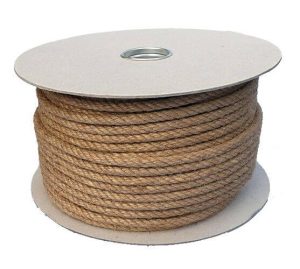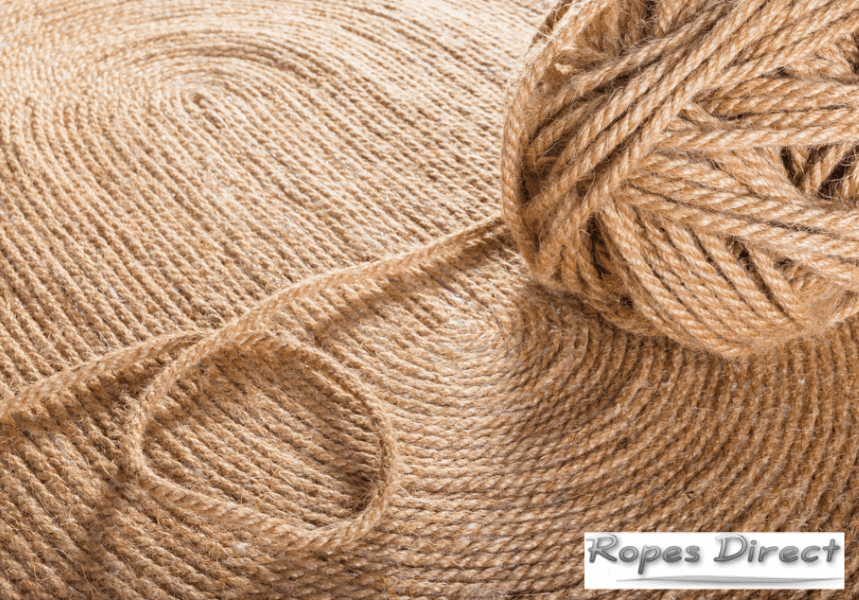As a family business that has lived and breathed rope for over 100 years, perhaps we’re biased. But we genuinely find the process of making rope fascinating!
Maybe that’s why, over 25 years ago – on a rainy day in Norfolk – we built our very own rope making machine. Based on the principles of a classic ropewalk, this is designed to twist individual twines together to create strands, whilst simultaneously twisting these strands together to form a rope.
Recently, we dragged our makeshift 1990s ‘ropewalk’ out of the cupboard. And to our delight – thanks to the skill and knowledge of our in-house team – it still works an absolute treat!
Here’s how the magic happens.
Twisting jute rope on our DIY ropewalk
A (surprisingly) simple two-step process.
Step 1: Prepare the jute
To create our natural jute rope, Russell threads jute twine up and down the ropewalk, winding it around hooks at either end.
Once he’s finished threading, and cut and tied off the twine – we’re ready to roll!
This stage is actually why it’s called a rope ‘walk’…Our DIY rope maker has been set up to create a fairly short rope, so it’s pretty quick and easy to go back and forth between the two ends. But if you’d like to make a longer jute rope, the pillars need to be positioned further apart – and your step count would soon rack up!
Step 2: Twist it
Fitted with an electric motor, it takes just one push of a button to power up the machine.
Turn it on and the three hooks at the top end of the ropewalk begin to twist the twine into three strands, gradually building up tension. Once they’re tight enough, these strands naturally spin themselves into one thick jute rope.
Simultaneously, Russell runs a ‘former’ along the length of the ropewalk. This handheld device prevents the strands from twisting loosely or in a disorganised manner; instead, encouraging them to wind evenly.

Traditional jute rope made in 2023
Our latest YouTube video may show Russell creating a perfect length of jute in a matter of seconds – using only our ‘vintage’ rope making machine. But this isn’t how the natural jute ropes available in our store are actually made!
Not many places still use this traditional method. In fact, one of the few remaining working ropewalks is located at Chatham Dockyard in Kent. Rope has been made there for over 400 years, and it’s still produced in almost exactly the same way today – using traditional methods and 150-year-old equipment. It’s open to the public so you can see it yourself.

Fast forward to the present day at RopesDirect, and you’ll be pleased to know, all of the jute ropes that we sell are produced (not by our own fair hands!), but at a modern-day factory.
Manufactured by one of our trusted European partners, they have the same three-strand construction as our DIY jute rope – yet also have a robust polypropylene core. And therefore you can expect a consistently high-quality product that’s built to last. All of our jute ropes benefit from a range of other useful properties. For example, they’re:
- lightweight yet strong
- durable and hard-wearing
- resistant to heat and UV light
- supple and flexible
- soft to touch

Shop our professionally made jute rope today
We currently stock jute ropes in diameters ranging from 4mm – 36mm, which can be bought by the metre, wound on reels or in coils. All of which are available for an affordable price, and eligible for next day delivery, provided your order is placed by 12pm.
Browse the collection, and if you have any questions – about traditional jute rope, how to make rope or even the history of the traditional ropewalk – please don’t hesitate to get in touch. Send your enquiry via our online contact form and we’ll respond as soon as possible.
If you enjoyed our video on how to make jute rope, it may also be worth subscribing to our YouTube channel. We’ve put together a library of fab, educational videos – with lots of information about RopesDirect, our products and how to make the most of your rope.

